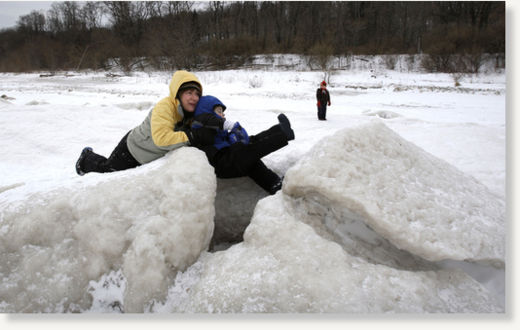
Winter enthusiasts have been flocking to Bradford Beach, the Doctors Park beach and other spots along the Lake Michigan shoreline since last week's blizzard to check out a bizarre lunar landscape of craters, boulders and rounded mounds carved from the shoreline ice shelf by wind and waves.
Many are climbing inside ice volcanoes - ice cones several feet high that form along the lake when waves force water up through the ice.
"It's pretty cozy in here; I'm not going to lie," said Marna Lamson, 24, of Milwaukee, as she huddled inside an ice volcano close to shore. "It's very sheltered from the elements. The bottom is snow and ice."
While they may be fascinating to explore, naturalists warn that ice volcanoes also can be treacherous. Even if they're not spouting water because the mouth that links them to the lake has frozen over, volcano bases can quickly change from snow and ice to water, depending on conditions.
Ice shelves also can break apart unexpectedly with changes in temperature and wave action, said Don Quintenz, director of education at the Schlitz Audubon Center in Bayside.
"You can fall through the ice, so you have to be very careful," he said. "I've studied the ice, and I'm still amazed by how fast things can get soft, and what was solid becomes unsolid."
Shoreline ice shelves may be frozen to the lake bottom, or water could be moving beneath them. Sometimes, it's hard to tell, Quintenz said.
He will lead a Feb. 17 hike exploring ice volcanoes (also called ice-canoes) and ice caves along the nature center's shoreline.
Ice volcanoes like the ones at Bradford Beach and Schlitz Audubon Nature Center are rare, Quintenz said. They're found only along beaches with relatively high amounts of wave energy from the lake, he said.
If you're wondering how ice volcanoes form, Bryan Yeaton of The Weather Notebook nationally syndicated radio show explains:
"As winter ice begins to build along the shores of large lakes, it is jostled, broken, and shifted by the winds and wave motions on the waters. When winds blow onshore, they can build an ice shelf - a jumble of ice chunks that anchors on the shore but extends some distance back into the water. Amongst the numerous ice blocks comprising a shelf, many open tunnels lead back to the lake waters.
"To build a good ice volcano cone, the surface air temperature must be several degrees below freezing and lake waves several feet high and breaking onshore. As the waves strike the edge of the ice shelf, pulses of wave energy flow beneath the ice. Upon reaching the open end of a tunnel, the wave forces water to erupt out through the ice. If the hole has been covered with snow, the eruption may spray snow outward like a volcanic gas cloud.
"As the ejected water falls back onto the ice, it quickly freezes and begins the formation of an ice cone, a process very similar to the building of a lava cone surrounding a geologic volcanic vent."
"Like rock volcanoes, ice volcano vents can heal over and become dormant during periods of low wave action," Yeaton said. "They lie in wait for a strong wave surge to awaken them back to explosive activity."



Reader Comments
to our Newsletter